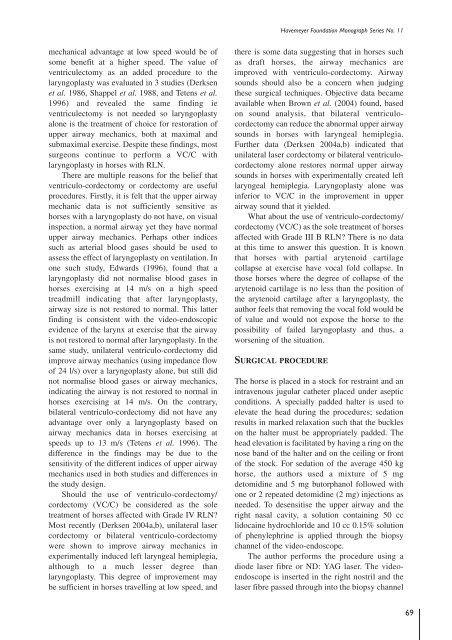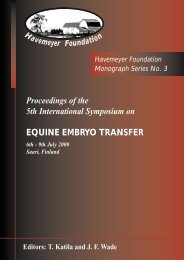Proceedings of a Workshop on - The Havemeyer Foundation
Proceedings of a Workshop on - The Havemeyer Foundation
Proceedings of a Workshop on - The Havemeyer Foundation
Create successful ePaper yourself
Turn your PDF publications into a flip-book with our unique Google optimized e-Paper software.
<strong>Havemeyer</strong> Foundati<strong>on</strong> M<strong>on</strong>ograph Series No. 11<br />
mechanical advantage at low speed would be <str<strong>on</strong>g>of</str<strong>on</strong>g><br />
some benefit at a higher speed. <strong>The</strong> value <str<strong>on</strong>g>of</str<strong>on</strong>g><br />
ventriculectomy as an added procedure to the<br />
laryngoplasty was evaluated in 3 studies (Derksen<br />
et al. 1986, Shappel et al. 1988, and Tetens et al.<br />
1996) and revealed the same finding ie<br />
ventriculectomy is not needed so laryngoplasty<br />
al<strong>on</strong>e is the treatment <str<strong>on</strong>g>of</str<strong>on</strong>g> choice for restorati<strong>on</strong> <str<strong>on</strong>g>of</str<strong>on</strong>g><br />
upper airway mechanics, both at maximal and<br />
submaximal exercise. Despite these findings, most<br />
surge<strong>on</strong>s c<strong>on</strong>tinue to perform a VC/C with<br />
laryngoplasty in horses with RLN.<br />
<strong>The</strong>re are multiple reas<strong>on</strong>s for the belief that<br />
ventriculo-cordectomy or cordectomy are useful<br />
procedures. Firstly, it is felt that the upper airway<br />
mechanic data is not sufficiently sensitive as<br />
horses with a laryngoplasty do not have, <strong>on</strong> visual<br />
inspecti<strong>on</strong>, a normal airway yet they have normal<br />
upper airway mechanics. Perhaps other indices<br />
such as arterial blood gases should be used to<br />
assess the effect <str<strong>on</strong>g>of</str<strong>on</strong>g> laryngoplasty <strong>on</strong> ventilati<strong>on</strong>. In<br />
<strong>on</strong>e such study, Edwards (1996), found that a<br />
laryngoplasty did not normalise blood gases in<br />
horses exercising at 14 m/s <strong>on</strong> a high speed<br />
treadmill indicating that after laryngoplasty,<br />
airway size is not restored to normal. This latter<br />
finding is c<strong>on</strong>sistent with the video-endoscopic<br />
evidence <str<strong>on</strong>g>of</str<strong>on</strong>g> the larynx at exercise that the airway<br />
is not restored to normal after laryngoplasty. In the<br />
same study, unilateral ventriculo-cordectomy did<br />
improve airway mechanics (using impedance flow<br />
<str<strong>on</strong>g>of</str<strong>on</strong>g> 24 l/s) over a laryngoplasty al<strong>on</strong>e, but still did<br />
not normalise blood gases or airway mechanics,<br />
indicating the airway is not restored to normal in<br />
horses exercising at 14 m/s. On the c<strong>on</strong>trary,<br />
bilateral ventriculo-cordectomy did not have any<br />
advantage over <strong>on</strong>ly a laryngoplasty based <strong>on</strong><br />
airway mechanics data in horses exercising at<br />
speeds up to 13 m/s (Tetens et al. 1996). <strong>The</strong><br />
difference in the findings may be due to the<br />
sensitivity <str<strong>on</strong>g>of</str<strong>on</strong>g> the different indices <str<strong>on</strong>g>of</str<strong>on</strong>g> upper airway<br />
mechanics used in both studies and differences in<br />
the study design.<br />
Should the use <str<strong>on</strong>g>of</str<strong>on</strong>g> ventriculo-cordectomy/<br />
cordectomy (VC/C) be c<strong>on</strong>sidered as the sole<br />
treatment <str<strong>on</strong>g>of</str<strong>on</strong>g> horses affected with Grade IV RLN?<br />
Most recently (Derksen 2004a,b), unilateral laser<br />
cordectomy or bilateral ventriculo-cordectomy<br />
were shown to improve airway mechanics in<br />
experimentally induced left laryngeal hemiplegia,<br />
although to a much lesser degree than<br />
laryngoplasty. This degree <str<strong>on</strong>g>of</str<strong>on</strong>g> improvement may<br />
be sufficient in horses travelling at low speed, and<br />
there is some data suggesting that in horses such<br />
as draft horses, the airway mechanics are<br />
improved with ventriculo-cordectomy. Airway<br />
sounds should also be a c<strong>on</strong>cern when judging<br />
these surgical techniques. Objective data became<br />
available when Brown et al. (2004) found, based<br />
<strong>on</strong> sound analysis, that bilateral ventriculocordectomy<br />
can reduce the abnormal upper airway<br />
sounds in horses with laryngeal hemiplegia.<br />
Further data (Derksen 2004a,b) indicated that<br />
unilateral laser cordectomy or bilateral ventriculocordectomy<br />
al<strong>on</strong>e restores normal upper airway<br />
sounds in horses with experimentally created left<br />
laryngeal hemiplegia. Laryngoplasty al<strong>on</strong>e was<br />
inferior to VC/C in the improvement in upper<br />
airway sound that it yielded.<br />
What about the use <str<strong>on</strong>g>of</str<strong>on</strong>g> ventriculo-cordectomy/<br />
cordectomy (VC/C) as the sole treatment <str<strong>on</strong>g>of</str<strong>on</strong>g> horses<br />
affected with Grade III B RLN? <strong>The</strong>re is no data<br />
at this time to answer this questi<strong>on</strong>. It is known<br />
that horses with partial arytenoid cartilage<br />
collapse at exercise have vocal fold collapse. In<br />
those horses where the degree <str<strong>on</strong>g>of</str<strong>on</strong>g> collapse <str<strong>on</strong>g>of</str<strong>on</strong>g> the<br />
arytenoid cartilage is no less than the positi<strong>on</strong> <str<strong>on</strong>g>of</str<strong>on</strong>g><br />
the arytenoid cartilage after a laryngoplasty, the<br />
author feels that removing the vocal fold would be<br />
<str<strong>on</strong>g>of</str<strong>on</strong>g> value and would not expose the horse to the<br />
possibility <str<strong>on</strong>g>of</str<strong>on</strong>g> failed laryngoplasty and thus, a<br />
worsening <str<strong>on</strong>g>of</str<strong>on</strong>g> the situati<strong>on</strong>.<br />
SURGICAL PROCEDURE<br />
<strong>The</strong> horse is placed in a stock for restraint and an<br />
intravenous jugular catheter placed under aseptic<br />
c<strong>on</strong>diti<strong>on</strong>s. A specially padded halter is used to<br />
elevate the head during the procedures; sedati<strong>on</strong><br />
results in marked relaxati<strong>on</strong> such that the buckles<br />
<strong>on</strong> the halter must be appropriately padded. <strong>The</strong><br />
head elevati<strong>on</strong> is facilitated by having a ring <strong>on</strong> the<br />
nose band <str<strong>on</strong>g>of</str<strong>on</strong>g> the halter and <strong>on</strong> the ceiling or fr<strong>on</strong>t<br />
<str<strong>on</strong>g>of</str<strong>on</strong>g> the stock. For sedati<strong>on</strong> <str<strong>on</strong>g>of</str<strong>on</strong>g> the average 450 kg<br />
horse, the authors used a mixture <str<strong>on</strong>g>of</str<strong>on</strong>g> 5 mg<br />
detomidine and 5 mg butorphanol followed with<br />
<strong>on</strong>e or 2 repeated detomidine (2 mg) injecti<strong>on</strong>s as<br />
needed. To desensitise the upper airway and the<br />
right nasal cavity, a soluti<strong>on</strong> c<strong>on</strong>taining 50 cc<br />
lidocaine hydrochloride and 10 cc 0.15% soluti<strong>on</strong><br />
<str<strong>on</strong>g>of</str<strong>on</strong>g> phenylephrine is applied through the biopsy<br />
channel <str<strong>on</strong>g>of</str<strong>on</strong>g> the video-endoscope.<br />
<strong>The</strong> author performs the procedure using a<br />
diode laser fibre or ND: YAG laser. <strong>The</strong> videoendoscope<br />
is inserted in the right nostril and the<br />
laser fibre passed through into the biopsy channel<br />
69








